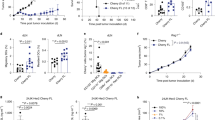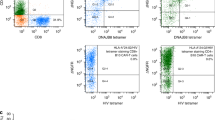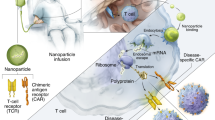Abstract
Even though renal cell carcinomas (RCC) are thought to be immunogenic, many tumors express variations in surface molecules and intracellular proteins that hinder induction of optimal antitumor responses. Interferon gamma (IFNγ) stimulation can correct some of these deficiencies. Therefore, we introduced the complementary DNA (cDNA) encoding human IFNγ into a well-characterized RCC line that has been selected for development of an allogeneic tumor cell vaccine for treatment of patients with metastatic disease. Studies were performed to determine how endogenous IFNγ expression influences tumor cell immunogenicity. IFNγ transductants showed minimal increases in surface expression of MHC class I and adhesion molecules but expression of class II molecules was induced. Proteins of the transporter associated with antigen processing (TAP) and low molecular weight polypeptide (LMP) were constitutively expressed at high levels. The transductants stimulated allospecific cytotoxic T lymphocytes (CTL); however, they were not better than unmodified tumor cells in this capacity. Endogenous IFNγ expression enhanced tumor cell recognition by MHC-restricted, tumor antigen-specific CTL but suppressed recognition by non-MHC-restricted cytotoxic cells. Thus, the functional consequences of IFNγ expression varied with respect to the type of effector cell and were not always beneficial for tumor cell recognition.
This is a preview of subscription content, access via your institution
Access options
Subscribe to this journal
Receive 12 print issues and online access
$259.00 per year
only $21.58 per issue
Buy this article
- Purchase on Springer Link
- Instant access to full article PDF
Prices may be subject to local taxes which are calculated during checkout





Similar content being viewed by others
References
Ostrand-Rosenberg S . Tumor immunotherapy: the tumor cell as an antigen-presenting cell Curr Opin Immunol 1994 6: 722–727
Hellström KE, Hellström I, Chien L . Can co-stimulated tumor immunity be therapeutically efficacious? Immunol Rev 1995 145: 123–145
Blankenstein T, Rowley DA, Schreiber H . Cytokines and cancer: experimental systems Curr Opin Immunol 1991 3: 694–698
Oettgen HF . Cytokines in clinical cancer therapy Curr Opin Immunol 1991 3: 699–705
Pardoll D . Immunotherapy with cytokine gene-transduced tumor cells: the next wave in gene therapy for cancer Curr Opin Oncol 1992 4: 1124–1129
Motzer RJ, Bander NH, Nanus DM . Renal-cell carcinoma New Engl J Med 1996 335: 865–875
Schendel DJ et al. Cellular and molecular analyses of MHC-restricted and non-MHC-restricted effector cells recognizing renal cell carcinomas: problems and perspectives for immunotherapy J Mol Med 1997 75: 400–413
Mule JJ, Shu S, Schwarz SL, Rosenberg SA . Adoptive immunotherapy of established pulmonary metastases with LAK cells and recombinant interleukin-2 Science 1984 225: 1487–1489
Ortaldo JR, Mason A, Overton R . Lymphokine-activated killer cells. Analysis of progenitors and effectors J Exp Med 1986 164: 1193–1205
Phillips JH, Lanier LL . Dissection of the lymphokine-activated killer phenomenon. Relative contribution of peripheral blood natural killer cells and T lymphocytes to cytolysis J Exp Med 1986 164: 814–825
Mingari MC et al. Phenotypic and functional analysis of human CD3+ and CD3− clones with ‘lymphokine-activated killer’ (LAK) activity. Frequent occurrence of CD3+ LAK clones which produce interleukin-2 Int J Cancer 1987 40: 495–498
Grimm EA, Mazumder A, Zhang HZ, Rosenberg SA . Lymphokine-activated killer cell phenomenon. Lysis of natural killer-resistant fresh solid tumor cells by interleukin 2-activated autologous human peripheral blood lymphocytes J Exp Med 1982 155: 1823–1841
Rosenberg S . Lymphokine-activated killer cells: a new approach to immunotherapy of cancer J Natl Cancer Inst 1985 75: 595–603
O'Shea J, Ortaldo JR . The biology of natural killer cell: insights into the molecular basis of function. In: Lewis CE, McGee JO (eds) The Natural Killer Cell Oxford University Press: New York 1992 pp 2–40
Zarcone D et al. Antibodies to adhesion molecules inhibit the lytic function of MHC-unrestricted cytotoxic cells by preventing their activation Cell Immunol 1992 143: 389–404
Trinchieri G . Recognition of major histocompatibility complex class I antigens by natural killer cells J Exp Med 1994 180: 417–421
Belldegrun A et al. Human tumor infiltrating lymphocytes. Analysis of lymphokine mRNA expression and relevance to cancer immunotherapy J Immunol 1989 142: 4520–4526
Finke JH et al. Characterization of the cytolytic activity of CD4+ and CD8+ tumor-infiltrating lymphocytes in human renal cell carcinoma Cancer Res 1990 50: 2363–2370
Koo AS et al. Autologous tumor-specific cytotoxicity of tumor-infiltrating lymphocytes derived from human renal cell carcinoma J Immunother 1991 10: 347–354
Finke JH et al. Characterization of a human renal cell carcinoma specific cytotoxic CD8+ T cell line J Immunother 1992 11: 1–11
Schendel DJ et al. Tumor-specific lysis of human renal cell carcinomas by tumor-infiltrating lymphocytes. I. HLA-A2-restricted recognition of autologous and allogeneic tumor lines J Immunol 1993 151: 4209–4220
Bernhard H et al. Tumor associated antigens in human renal cell carcinoma: MHC-restricted recognition by cytotoxic T lymphocytes Tissue Antigens 1996 48: 22–31
Bernhard H et al. Recognition of human renal cell carcinoma and melanoma by HLA-A2- restricted cytotoxic T lymphocytes is mediated by shared peptide epitopes and up-regulated by interferon-gamma Scand J Immunol 1996 44: 285–292
Brouwnenstijn N et al. Renal-cell carcinoma-specific lysis by cytotoxic T-lymphocyte clones isolated from peripheral blood lymphocytes and tumor-infiltrating lymphocytes Int J Cancer 1996 68: 177–182
Boon T, Coulie PG, Van den Eynde B . Tumor antigens recognized by T cells Immunol Today 1997 18: 267–268
Gaugler B et al. A new gene coding for an antigen recognized by autologous cytolytic T lymphocytes on a human renal carcinoma Immunogenetics 1996 44: 323–330
Basham TY, Merigan TC . Recombinant interferon-g increases HLA-DR synthesis and expression J Immunol 1983 130: 1492–1494
Schwartz R et al. Induction of HLA class-II antigen expression on human carcinoma cell lines by IFN-Gamma Int J Cancer 1985 35: 245–250
el Asrar AM et al. Recombinant interferon-gamma induces HLA-DR expression on human corneal epithelial and endothelial cells in vitro: a preliminary report Br J Ophthalmol 1989 73: 587–590
Zarcone D et al. Antibodies to adhesion molecules inhibit the lytic function of MHC-unrestricted cytotoxic cells by preventing their activation Cell Immunol 1992 143: 389–404
Boehm U, Klamp T, Groot M, Howard JC . Cellular responses to interferon-gamma Annu Rev Immunol 1997 15: 749–795
Uebel S, Tampe R . Specificity of the proteasome and the TAP transporter Curr Opin Immunol 1999 11: 203–208
Spies T, DeMars R . Restored expression of major histocompatibility class I molecules by gene transfer of a putative peptide transporter Nature 1991 351: 323–324
Monaco JJ . Genes in the MHC that may affect antigen processing Curr Opin Immunol 1992 4: 70–73
Ogasawara M, Rosenberg SA . Enhanced expression of HLA molecules and stimulation of autologous human tumor infiltrating lymphocytes following transduction of melanoma cells with gamma-interferon genes Cancer Res 1993 53: 3561–3568
Abdel Wahab ZA et al. Transduction of human melanoma cells with the gamma interferon gene enhances cellular immunity Cancer Gene Ther 1994 1: 171–179
Zier KS, Gansbacher B . Tumour cell vaccines that secrete interleukin-2 (IL-2) and interferongamma (IFNgamma) are recognised by T cells while resisting destruction by natural killer (NK) cells Eur J Cancer 1996 32A: 1408–1412
Pende D et al. The susceptibility to natural killer cell-mediated lysis of HLA class I-positive melanomas reflects the expression of insufficient amounts of different HLA class I alleles Eur J Immunol 1998 28: 2384–2394
Taniguchi K et al. Interferon gamma induces lung colonization by intravenously inoculated B16 melanoma cells in parallel with enhanced expression of class I major histocompatibility complex antigens Proc Natl Acad Sci USA 1987 84: 3405–3409
Lollini P-L et al. Inhibition of tumor growth and enhancement of metastasis after transfection of the gamma-interferon gene Int J Cancer 1993 55: 320–329
Jantzer P, Schendel DJ . Human renal cell carcinoma antigen-specific cytotoxic T lymphocytes: antigen-driven selection and long-term persistence in vivo Cancer Res 1998 58: 3078–3086
Schendel DJ, Gansbacher B . Tumor-specific lysis of human renal cell carcinomas by tumor-infiltrating lymphocytes: modulation of recognition through retroviral transduction of tumor cells with interleukin 2 complementary DNA and exogenous alpha interferon treatment Cancer Res 1993 53: 4020–4025
Gastl G et al. Retroviral vector-mediated lymphokine gene transfer into human renal cancer cells Cancer Res 1992 52: 1–8
Restifo NR et al. Identification of human cancers deficient in antigen processing J Exp Med 1993 177: 265–272
Seliger B et al. Analysis of the major histocompatibility complex class I antigen presentation machinery in normal and malignant renal cells: evidence for deficiencies associated with transformation and progression Cancer Res 1996 56: 1756–1760
Quesada JR, Kurzrock R, Sherwin SA, Gutterman JU . Phase II studies of recombinant human interferon gamma in metastatic renal cell carcinoma J Biol Response Mod 1987 6: 20–27
Meyskens FL Jr et al. Recombinant human interferon gamma: adverse effects in high-risk stage I and II cutaneous malignant melanoma (letter) J Natl Cancer Inst 1990 82: 1071–1071
Allhoff EP et al. Current clinical relevance of immunotherapy in metastatic renal cell cancer World J Urol 1991 9: 228–231
Aulitzky W et al. Successful treatment of metastatic renal cell carcinoma with a biologically active dose of recombinant interferon-gamma J Clin Oncol 1989 7: 1875–1884
Otto F, Mackensen A, Mertelsmann R, Engelhardt R . Complete response of metastatic renal cell carcinoma to low-dose interferon-gamma treatment Cancer Immunol Immunother 1995 40: 115–118
Otto U, Schneider AW, Conrad S, Klosterhalfen H . Recombinant alpha-2 or gamma interferon in the treatment of metastatic renal cell carcinoma: results of two phase II/III trials Prog Clin Biol Res 1990 350: 275–282
Rosenberg SA . Karnofsky Memorial Lecture. The immunotherapy and gene therapy of cancer J Clin Oncol 1992 10: 180–199
Blankenstein T . Increasing tumour immunogenicity by genetic modification Eur J Cancer 1994 30A: 1182–1187
Pardoll DM, Topalian SL . The role of CD4+ T cell responses in antitumor immunity Curr Opin Immunol 1998 10: 588–594
Pardoll DM . Paracrine cytokine adjuvants in cancer immunotherapy Annu Rev Immunol 1995 13: 399–415
Itoh K, Tilden AB, Balch CM . Lysis of human solid tumor cells by lymphokine-activated natural killer cells J Immunol 1986 136: 3910–3915
Stotter H et al. Cytokines alter target cell susceptibility to lysis. II. Evaluation of tumor infiltrating lymphocytes J Immunol 1989 142: 1767–1773
Shieh DC, Kao KJ . Proportional amplification of individual HLA-A and -B antigens during upregulated expression of total class I HLA molecules Hum Immunol 1995 42: 174–180
Panelli MC et al. Interferon gamma (IFNgamma) gene transfer of an EMT6 tumor that is poorly responsive to IFNgamma stimulation: increase in tumor immunogenicity is accompanied by induction of a mouse class II transactivator and class II MHC Cancer Immunol Immunother 1996 42: 99–107
Browder TM, Dunbar CE, Nienhuis AW . Private and public autocrine loops in neoplastic cells Cancer Cells 1989 1: 9–17
Porgador A et al. Antimetastatic vaccination of tumor-bearing mice with two types of IFN-gamma gene-inserted tumor cells J Immunol 1993 150: 1458–1470
Yin D et al. Interferon-gamma induces a decrease in the susceptibility of human glioma cells to lysis by lymphokine-activated killer cells Neurosurgery 1994 35: 113–118
Takahashi C et al. Cytokine modulation of interactions between cultured human renal tubular and lymphoid blast cells Pathol Res Pract 1995 191: 1–7
Schendel DJ, Wank R . Production of human T cell growth factor Hum Immunol 1981 2: 325–332
Gansbacher B et al. Retroviral gene transfer induced constitutive expression of interleukin-2 or interferon-gamma in irradiated human melanoma cells Blood 1992 80: 2817–2825
Schendel DJ, Wank R, Dupont B . Standardization of the human in vitro cell-mediated lympholysis technique Tissue Antigens 1979 13: 112–120
Lämmli UK . Cleavage of structural proteins during the assembly of the head of bacteriophage T4 Nature 1970 227: 680–685
Meyer TH et al. Functional expression and purification of the ABC transporter complex associated with antigen processing (TAP) in insect cells FEBS Lett 1994 351: 443–447
Van Endert PM et al. A sequential model for peptide binding and transport by the transporters associated with antigen processing Immunity 1994 1: 491–500
Ehring B et al. Effects of major histocompatibility complex encoded subunits on the peptidase and proteolytic activities of human 20s proteasomes: cleavage of proteins and antigenic peptides Eur J Biochem 1996 235: 404–415
Acknowledgements
We thank R Oberneder and A Hofstetter for their sustained clinical support, M Morawietz and H Stepp for help with graphics and J Johnson and D Novick for providing relevant mAbs. This work was supported by grants of the Deutsche Forschungsgemeinschaft (SFB455 B10 and Ho1596/3-2).
Author information
Authors and Affiliations
Rights and permissions
About this article
Cite this article
Schendel, D., Falk, C., Nößner, E. et al. Gene transfer of human interferon gamma complementary DNA into a renal cell carcinoma line enhances MHC-restricted cytotoxic T lymphocyte recognition but suppresses non-MHC-restricted effector cell activity. Gene Ther 7, 950–959 (2000). https://doi.org/10.1038/sj.gt.3301187
Received:
Accepted:
Published:
Issue Date:
DOI: https://doi.org/10.1038/sj.gt.3301187
Keywords
This article is cited by
-
Harnessing innate and adaptive immunity for adoptive cell therapy of renal cell carcinoma
Journal of Molecular Medicine (2009)
-
Cell-based vaccines for renal cell carcinoma: genetically-engineered tumor cells and monocyte-derived dendritic cells
World Journal of Urology (2005)
-
The cellular and molecular basis of natural antitumor immunity in renal cell carcinoma patients
Der Urologe (2004)



